Importance of Company Culture and Purpose
VerifiedAdded on 2023/01/07
|12
|3846
|35
AI Summary
The report explains the importance of company culture and purpose in the growth of Starbucks. It discusses the impact of company culture on operational efficiency and innovation. It also highlights the significance of purpose in driving profitability and employee motivation. The report suggests that participative and transformational leadership styles can contribute to the growth of Starbucks. It also emphasizes the importance of CSR in enhancing the company's reputation and consumer goodwill. Additionally, the report provides a comparison and contrast between different leadership styles and their implications for the organization. Finally, it discusses the importance of SWOT and PESTLE analysis in understanding the internal and external factors affecting Starbucks.
Contribute Materials
Your contribution can guide someone’s learning journey. Share your
documents today.
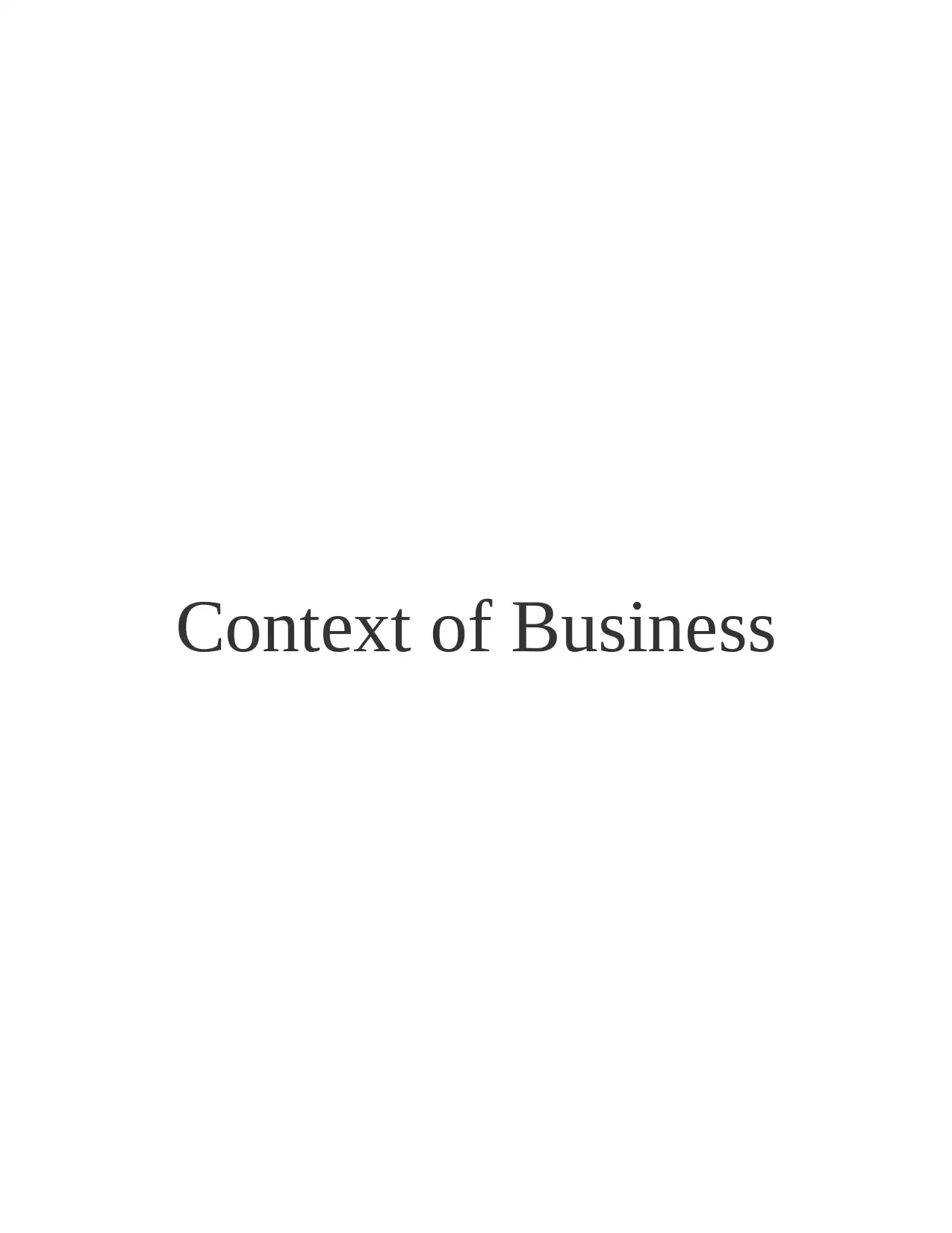
Context of Business
Secure Best Marks with AI Grader
Need help grading? Try our AI Grader for instant feedback on your assignments.
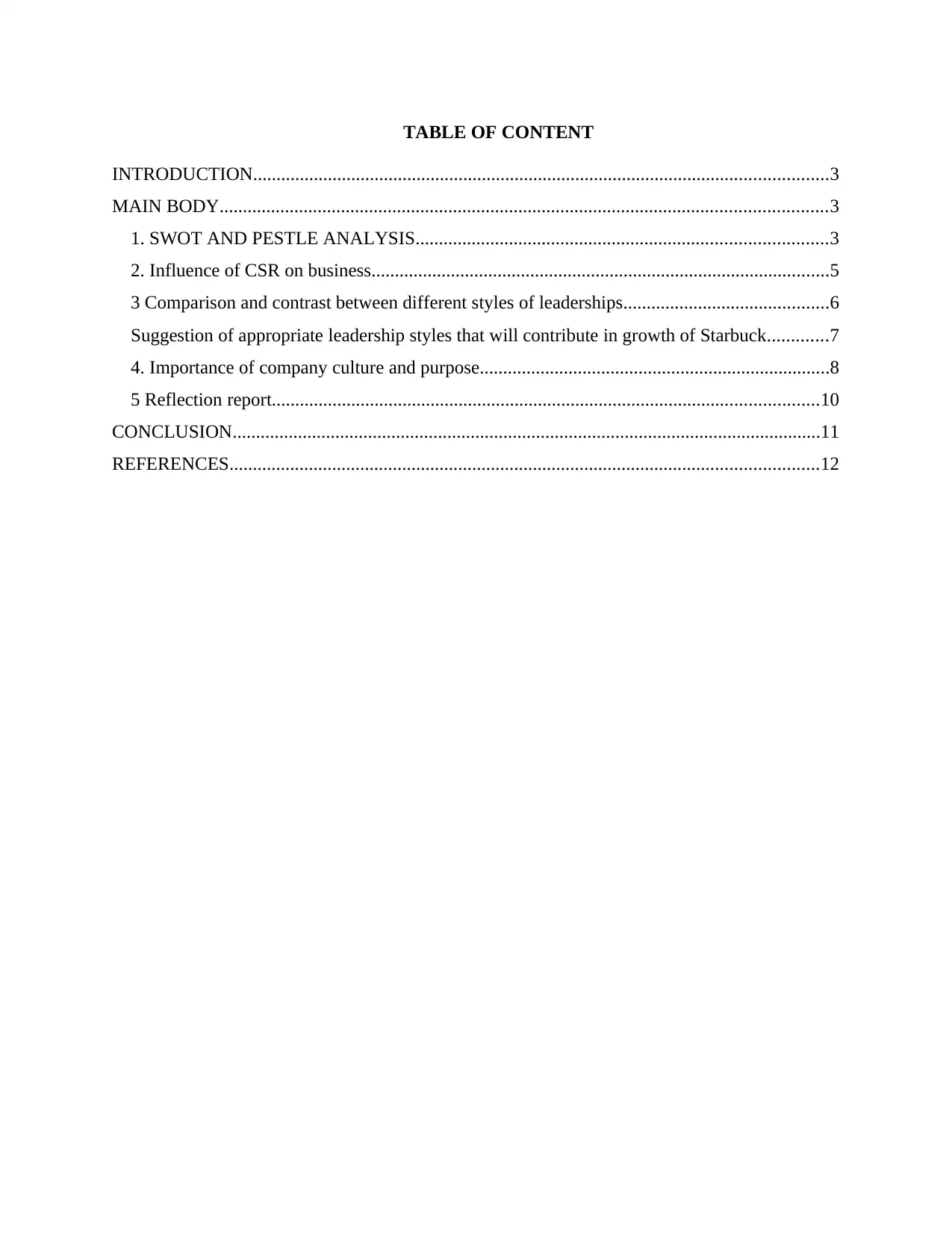
TABLE OF CONTENT
INTRODUCTION...........................................................................................................................3
MAIN BODY..................................................................................................................................3
1. SWOT AND PESTLE ANALYSIS........................................................................................3
2. Influence of CSR on business..................................................................................................5
3 Comparison and contrast between different styles of leaderships............................................6
Suggestion of appropriate leadership styles that will contribute in growth of Starbuck.............7
4. Importance of company culture and purpose...........................................................................8
5 Reflection report.....................................................................................................................10
CONCLUSION..............................................................................................................................11
REFERENCES..............................................................................................................................12
INTRODUCTION...........................................................................................................................3
MAIN BODY..................................................................................................................................3
1. SWOT AND PESTLE ANALYSIS........................................................................................3
2. Influence of CSR on business..................................................................................................5
3 Comparison and contrast between different styles of leaderships............................................6
Suggestion of appropriate leadership styles that will contribute in growth of Starbuck.............7
4. Importance of company culture and purpose...........................................................................8
5 Reflection report.....................................................................................................................10
CONCLUSION..............................................................................................................................11
REFERENCES..............................................................................................................................12
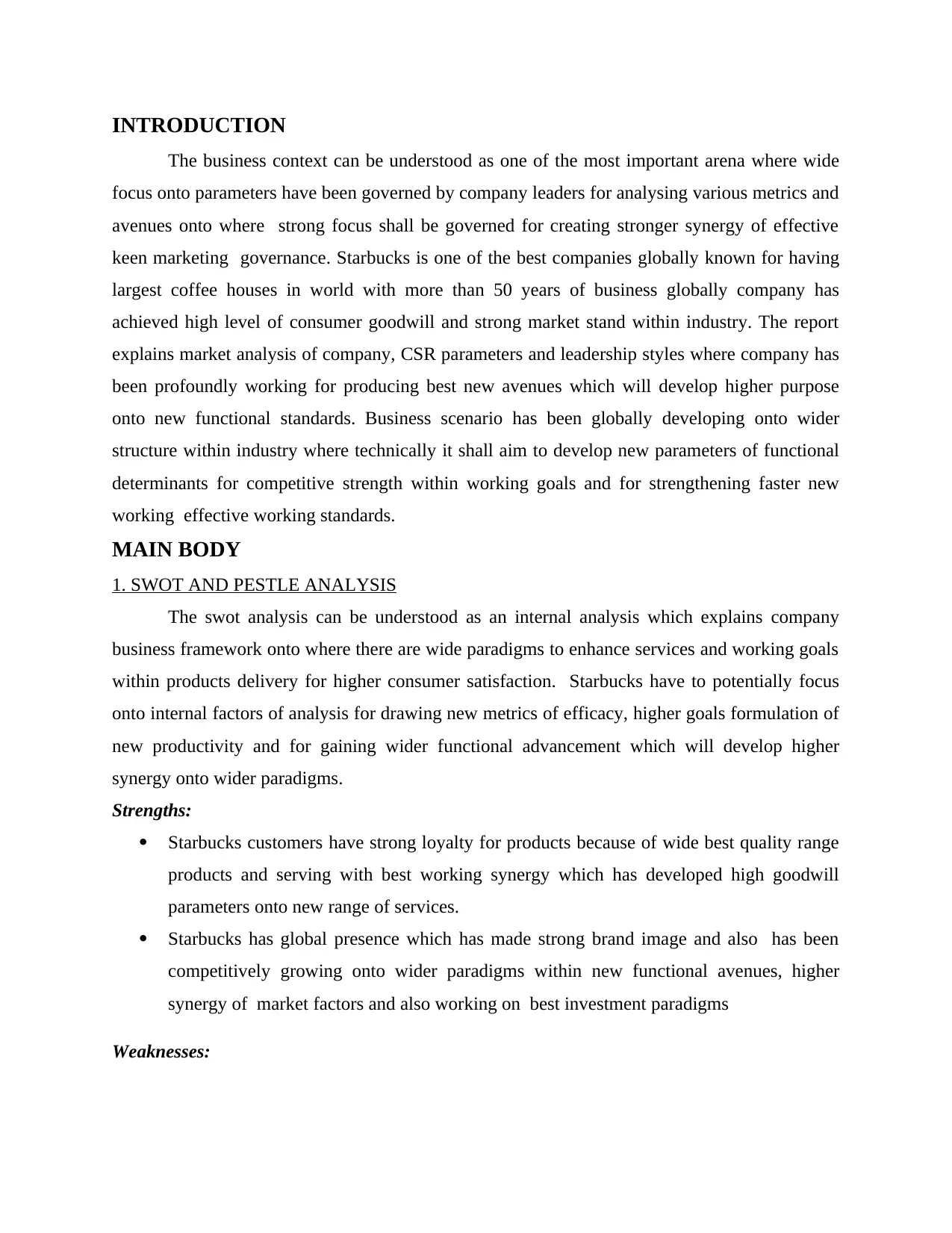
INTRODUCTION
The business context can be understood as one of the most important arena where wide
focus onto parameters have been governed by company leaders for analysing various metrics and
avenues onto where strong focus shall be governed for creating stronger synergy of effective
keen marketing governance. Starbucks is one of the best companies globally known for having
largest coffee houses in world with more than 50 years of business globally company has
achieved high level of consumer goodwill and strong market stand within industry. The report
explains market analysis of company, CSR parameters and leadership styles where company has
been profoundly working for producing best new avenues which will develop higher purpose
onto new functional standards. Business scenario has been globally developing onto wider
structure within industry where technically it shall aim to develop new parameters of functional
determinants for competitive strength within working goals and for strengthening faster new
working effective working standards.
MAIN BODY
1. SWOT AND PESTLE ANALYSIS
The swot analysis can be understood as an internal analysis which explains company
business framework onto where there are wide paradigms to enhance services and working goals
within products delivery for higher consumer satisfaction. Starbucks have to potentially focus
onto internal factors of analysis for drawing new metrics of efficacy, higher goals formulation of
new productivity and for gaining wider functional advancement which will develop higher
synergy onto wider paradigms.
Strengths:
Starbucks customers have strong loyalty for products because of wide best quality range
products and serving with best working synergy which has developed high goodwill
parameters onto new range of services.
Starbucks has global presence which has made strong brand image and also has been
competitively growing onto wider paradigms within new functional avenues, higher
synergy of market factors and also working on best investment paradigms
Weaknesses:
The business context can be understood as one of the most important arena where wide
focus onto parameters have been governed by company leaders for analysing various metrics and
avenues onto where strong focus shall be governed for creating stronger synergy of effective
keen marketing governance. Starbucks is one of the best companies globally known for having
largest coffee houses in world with more than 50 years of business globally company has
achieved high level of consumer goodwill and strong market stand within industry. The report
explains market analysis of company, CSR parameters and leadership styles where company has
been profoundly working for producing best new avenues which will develop higher purpose
onto new functional standards. Business scenario has been globally developing onto wider
structure within industry where technically it shall aim to develop new parameters of functional
determinants for competitive strength within working goals and for strengthening faster new
working effective working standards.
MAIN BODY
1. SWOT AND PESTLE ANALYSIS
The swot analysis can be understood as an internal analysis which explains company
business framework onto where there are wide paradigms to enhance services and working goals
within products delivery for higher consumer satisfaction. Starbucks have to potentially focus
onto internal factors of analysis for drawing new metrics of efficacy, higher goals formulation of
new productivity and for gaining wider functional advancement which will develop higher
synergy onto wider paradigms.
Strengths:
Starbucks customers have strong loyalty for products because of wide best quality range
products and serving with best working synergy which has developed high goodwill
parameters onto new range of services.
Starbucks has global presence which has made strong brand image and also has been
competitively growing onto wider paradigms within new functional avenues, higher
synergy of market factors and also working on best investment paradigms
Weaknesses:
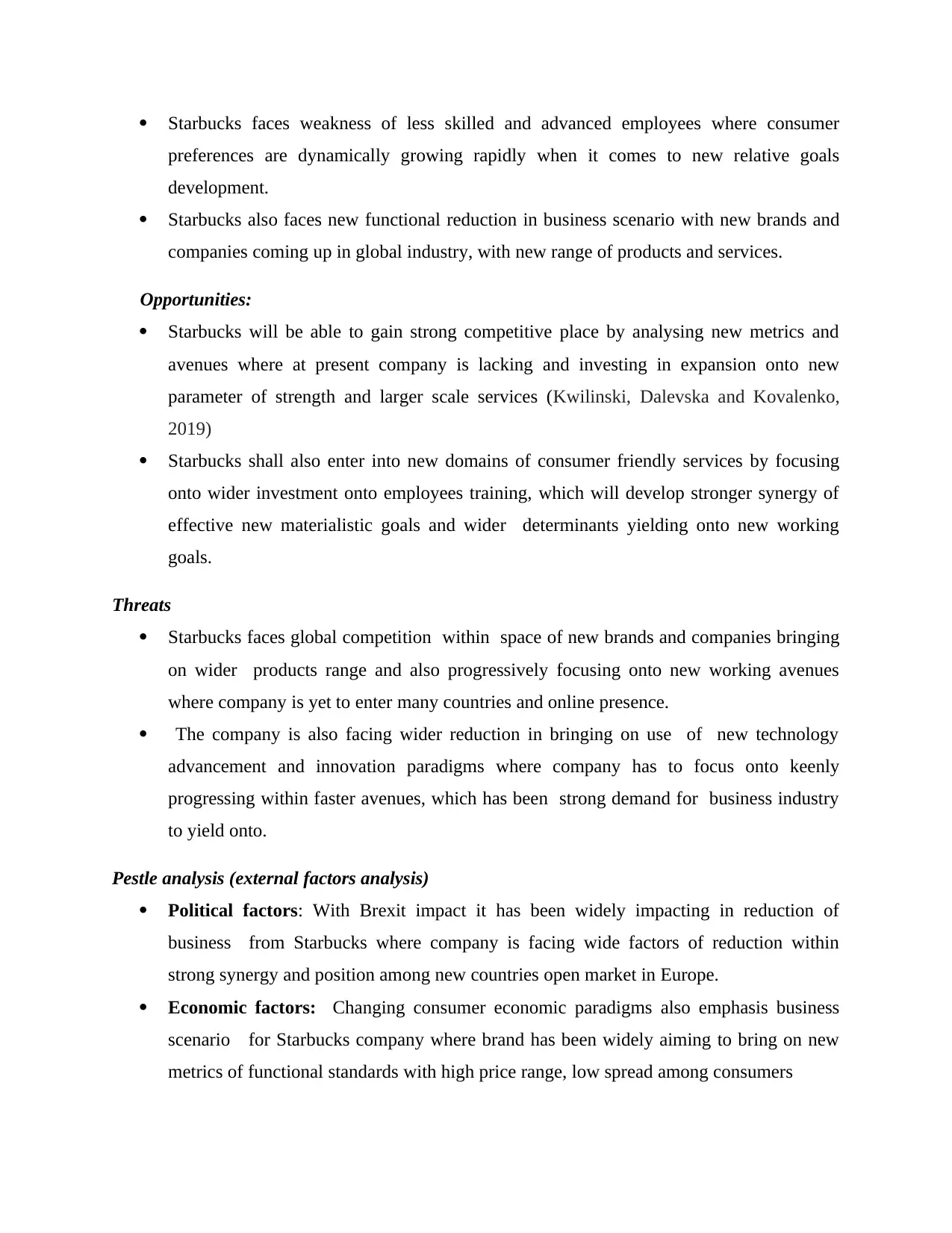
Starbucks faces weakness of less skilled and advanced employees where consumer
preferences are dynamically growing rapidly when it comes to new relative goals
development.
Starbucks also faces new functional reduction in business scenario with new brands and
companies coming up in global industry, with new range of products and services.
Opportunities:
Starbucks will be able to gain strong competitive place by analysing new metrics and
avenues where at present company is lacking and investing in expansion onto new
parameter of strength and larger scale services (Kwilinski, Dalevska and Kovalenko,
2019)
Starbucks shall also enter into new domains of consumer friendly services by focusing
onto wider investment onto employees training, which will develop stronger synergy of
effective new materialistic goals and wider determinants yielding onto new working
goals.
Threats
Starbucks faces global competition within space of new brands and companies bringing
on wider products range and also progressively focusing onto new working avenues
where company is yet to enter many countries and online presence.
The company is also facing wider reduction in bringing on use of new technology
advancement and innovation paradigms where company has to focus onto keenly
progressing within faster avenues, which has been strong demand for business industry
to yield onto.
Pestle analysis (external factors analysis)
Political factors: With Brexit impact it has been widely impacting in reduction of
business from Starbucks where company is facing wide factors of reduction within
strong synergy and position among new countries open market in Europe.
Economic factors: Changing consumer economic paradigms also emphasis business
scenario for Starbucks company where brand has been widely aiming to bring on new
metrics of functional standards with high price range, low spread among consumers
preferences are dynamically growing rapidly when it comes to new relative goals
development.
Starbucks also faces new functional reduction in business scenario with new brands and
companies coming up in global industry, with new range of products and services.
Opportunities:
Starbucks will be able to gain strong competitive place by analysing new metrics and
avenues where at present company is lacking and investing in expansion onto new
parameter of strength and larger scale services (Kwilinski, Dalevska and Kovalenko,
2019)
Starbucks shall also enter into new domains of consumer friendly services by focusing
onto wider investment onto employees training, which will develop stronger synergy of
effective new materialistic goals and wider determinants yielding onto new working
goals.
Threats
Starbucks faces global competition within space of new brands and companies bringing
on wider products range and also progressively focusing onto new working avenues
where company is yet to enter many countries and online presence.
The company is also facing wider reduction in bringing on use of new technology
advancement and innovation paradigms where company has to focus onto keenly
progressing within faster avenues, which has been strong demand for business industry
to yield onto.
Pestle analysis (external factors analysis)
Political factors: With Brexit impact it has been widely impacting in reduction of
business from Starbucks where company is facing wide factors of reduction within
strong synergy and position among new countries open market in Europe.
Economic factors: Changing consumer economic paradigms also emphasis business
scenario for Starbucks company where brand has been widely aiming to bring on new
metrics of functional standards with high price range, low spread among consumers
Secure Best Marks with AI Grader
Need help grading? Try our AI Grader for instant feedback on your assignments.
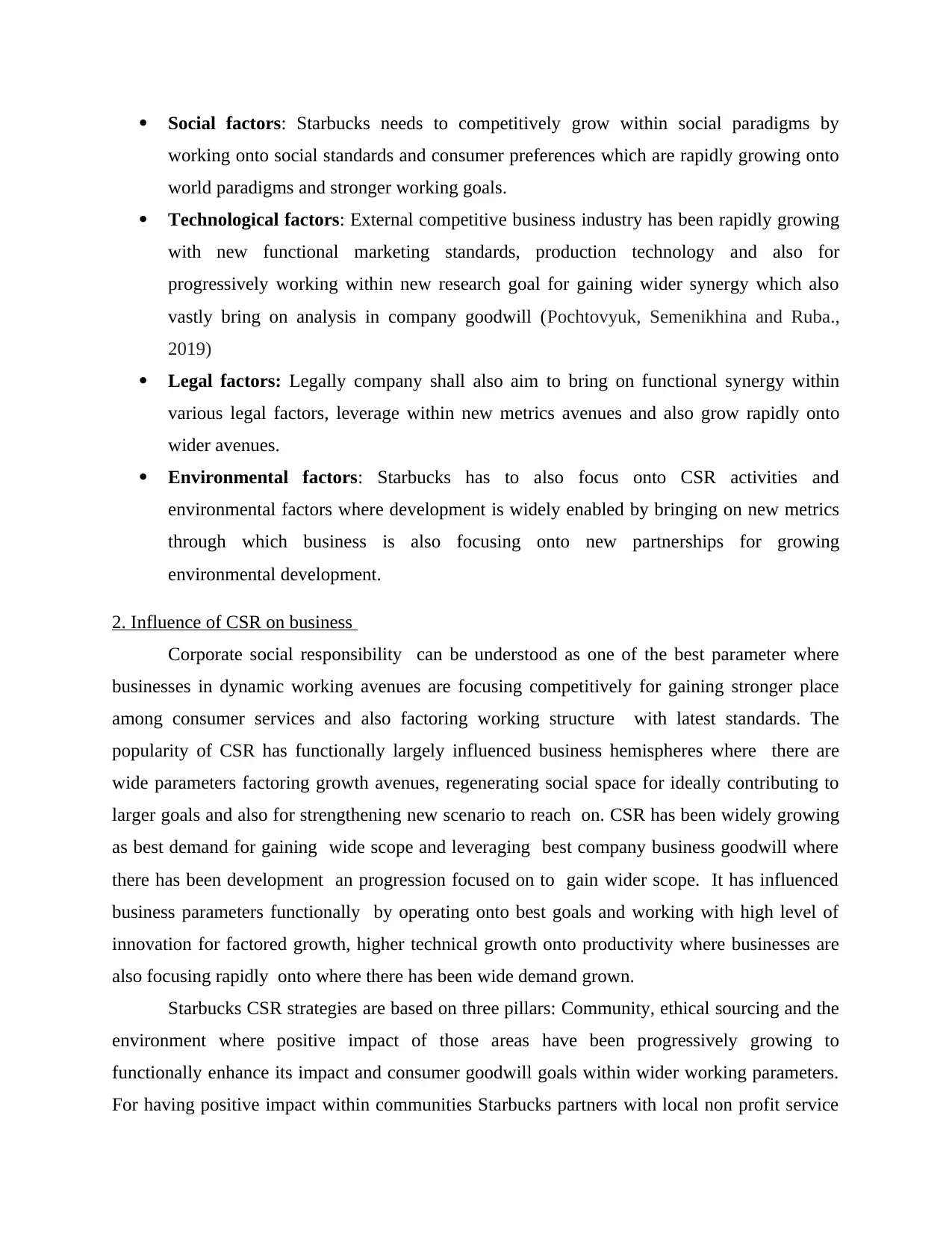
Social factors: Starbucks needs to competitively grow within social paradigms by
working onto social standards and consumer preferences which are rapidly growing onto
world paradigms and stronger working goals.
Technological factors: External competitive business industry has been rapidly growing
with new functional marketing standards, production technology and also for
progressively working within new research goal for gaining wider synergy which also
vastly bring on analysis in company goodwill (Pochtovyuk, Semenikhina and Ruba.,
2019)
Legal factors: Legally company shall also aim to bring on functional synergy within
various legal factors, leverage within new metrics avenues and also grow rapidly onto
wider avenues.
Environmental factors: Starbucks has to also focus onto CSR activities and
environmental factors where development is widely enabled by bringing on new metrics
through which business is also focusing onto new partnerships for growing
environmental development.
2. Influence of CSR on business
Corporate social responsibility can be understood as one of the best parameter where
businesses in dynamic working avenues are focusing competitively for gaining stronger place
among consumer services and also factoring working structure with latest standards. The
popularity of CSR has functionally largely influenced business hemispheres where there are
wide parameters factoring growth avenues, regenerating social space for ideally contributing to
larger goals and also for strengthening new scenario to reach on. CSR has been widely growing
as best demand for gaining wide scope and leveraging best company business goodwill where
there has been development an progression focused on to gain wider scope. It has influenced
business parameters functionally by operating onto best goals and working with high level of
innovation for factored growth, higher technical growth onto productivity where businesses are
also focusing rapidly onto where there has been wide demand grown.
Starbucks CSR strategies are based on three pillars: Community, ethical sourcing and the
environment where positive impact of those areas have been progressively growing to
functionally enhance its impact and consumer goodwill goals within wider working parameters.
For having positive impact within communities Starbucks partners with local non profit service
working onto social standards and consumer preferences which are rapidly growing onto
world paradigms and stronger working goals.
Technological factors: External competitive business industry has been rapidly growing
with new functional marketing standards, production technology and also for
progressively working within new research goal for gaining wider synergy which also
vastly bring on analysis in company goodwill (Pochtovyuk, Semenikhina and Ruba.,
2019)
Legal factors: Legally company shall also aim to bring on functional synergy within
various legal factors, leverage within new metrics avenues and also grow rapidly onto
wider avenues.
Environmental factors: Starbucks has to also focus onto CSR activities and
environmental factors where development is widely enabled by bringing on new metrics
through which business is also focusing onto new partnerships for growing
environmental development.
2. Influence of CSR on business
Corporate social responsibility can be understood as one of the best parameter where
businesses in dynamic working avenues are focusing competitively for gaining stronger place
among consumer services and also factoring working structure with latest standards. The
popularity of CSR has functionally largely influenced business hemispheres where there are
wide parameters factoring growth avenues, regenerating social space for ideally contributing to
larger goals and also for strengthening new scenario to reach on. CSR has been widely growing
as best demand for gaining wide scope and leveraging best company business goodwill where
there has been development an progression focused on to gain wider scope. It has influenced
business parameters functionally by operating onto best goals and working with high level of
innovation for factored growth, higher technical growth onto productivity where businesses are
also focusing rapidly onto where there has been wide demand grown.
Starbucks CSR strategies are based on three pillars: Community, ethical sourcing and the
environment where positive impact of those areas have been progressively growing to
functionally enhance its impact and consumer goodwill goals within wider working parameters.
For having positive impact within communities Starbucks partners with local non profit service

companies and developing larger transactions with best local service development goals where it
also provides training opportunities for youth in communities (Prodanova, Kevorkova and
Bochkareva,2019). Second pillar ethical sourcing analyses the way company sources its raw
materials within production of products serviced to consumers and ensuring that coffee, tea,
cocoa and other goods are responsibly and ethically produced and worked on among wider
business goals.
Company largely believes that success is linked to success and well being of local
suppliers and farmers who grow and produce wide categories of functional standards quality raw
supplies. Purchases are made of products from farms and manufacturers that adhere to certain
standards and ethical treatment paradigms for gaining strong industry presence within global
goodwill parameters. Within environment parameters Starbucks has build certified stores and are
committed to recycling and conserving water and energy resources within production. Starbucks
tries to be as much as environmental friendly as possible in every aspect where there are various
metrics onto where climate change is focused to be effectively managed on. Starbucks
functionally decided to invest in people and communities they work with and focuses to bring on
positive changes onto working parameters which also functionally enhances company services to
support environmental issues and rationally developing new metrics onto wider goals. With
satisfied stakeholders paradigms there has been wide analysis driven to yield focus onto working
with CSR metrics which results on long term goodwill growth and stronger synergy of functional
progression into new metrics which also enhances competitive progression onto wider industry
globally (Pyper, Doherty and Wilson, 2019)
3 Comparison and contrast between different styles of leaderships
Leaders are most crucial for an organisation as they provide appropriate guideline and
direction regarding the way task needed to be performed so that particular outcome can be
achieved in best possible manner. They have attractive and influencing personality that inspired
huge number of employees to work in specific manner for growth and success of enterprise
(Gandolfi and Stone, 2016). There are different types of leadership styles which can be used by
leaders of Starbuck in order to manage and motivate employees to give their best so that
company can attain its objectives. Therefore various leadership styles can be illustrated as
follows:
also provides training opportunities for youth in communities (Prodanova, Kevorkova and
Bochkareva,2019). Second pillar ethical sourcing analyses the way company sources its raw
materials within production of products serviced to consumers and ensuring that coffee, tea,
cocoa and other goods are responsibly and ethically produced and worked on among wider
business goals.
Company largely believes that success is linked to success and well being of local
suppliers and farmers who grow and produce wide categories of functional standards quality raw
supplies. Purchases are made of products from farms and manufacturers that adhere to certain
standards and ethical treatment paradigms for gaining strong industry presence within global
goodwill parameters. Within environment parameters Starbucks has build certified stores and are
committed to recycling and conserving water and energy resources within production. Starbucks
tries to be as much as environmental friendly as possible in every aspect where there are various
metrics onto where climate change is focused to be effectively managed on. Starbucks
functionally decided to invest in people and communities they work with and focuses to bring on
positive changes onto working parameters which also functionally enhances company services to
support environmental issues and rationally developing new metrics onto wider goals. With
satisfied stakeholders paradigms there has been wide analysis driven to yield focus onto working
with CSR metrics which results on long term goodwill growth and stronger synergy of functional
progression into new metrics which also enhances competitive progression onto wider industry
globally (Pyper, Doherty and Wilson, 2019)
3 Comparison and contrast between different styles of leaderships
Leaders are most crucial for an organisation as they provide appropriate guideline and
direction regarding the way task needed to be performed so that particular outcome can be
achieved in best possible manner. They have attractive and influencing personality that inspired
huge number of employees to work in specific manner for growth and success of enterprise
(Gandolfi and Stone, 2016). There are different types of leadership styles which can be used by
leaders of Starbuck in order to manage and motivate employees to give their best so that
company can attain its objectives. Therefore various leadership styles can be illustrated as
follows:
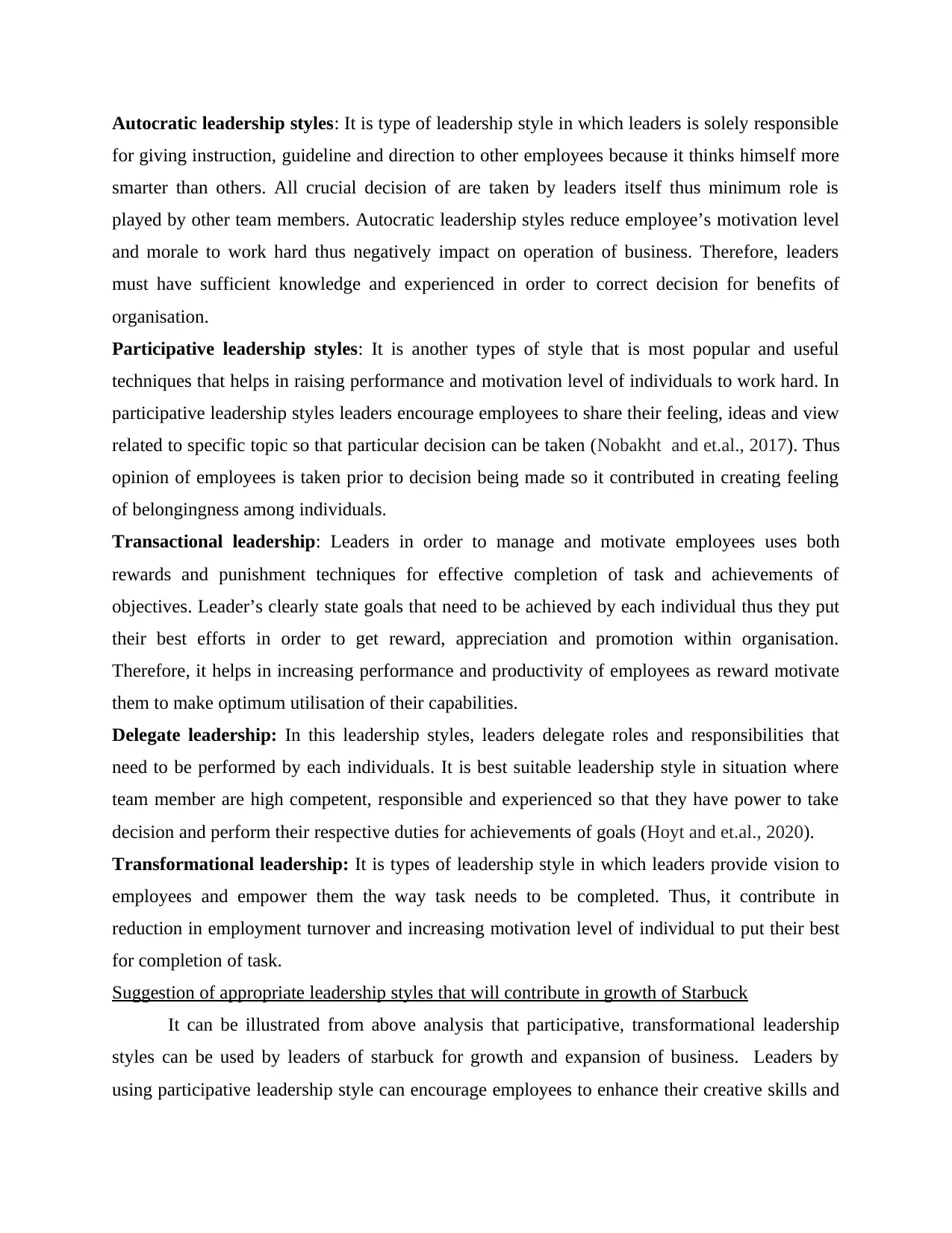
Autocratic leadership styles: It is type of leadership style in which leaders is solely responsible
for giving instruction, guideline and direction to other employees because it thinks himself more
smarter than others. All crucial decision of are taken by leaders itself thus minimum role is
played by other team members. Autocratic leadership styles reduce employee’s motivation level
and morale to work hard thus negatively impact on operation of business. Therefore, leaders
must have sufficient knowledge and experienced in order to correct decision for benefits of
organisation.
Participative leadership styles: It is another types of style that is most popular and useful
techniques that helps in raising performance and motivation level of individuals to work hard. In
participative leadership styles leaders encourage employees to share their feeling, ideas and view
related to specific topic so that particular decision can be taken (Nobakht and et.al., 2017). Thus
opinion of employees is taken prior to decision being made so it contributed in creating feeling
of belongingness among individuals.
Transactional leadership: Leaders in order to manage and motivate employees uses both
rewards and punishment techniques for effective completion of task and achievements of
objectives. Leader’s clearly state goals that need to be achieved by each individual thus they put
their best efforts in order to get reward, appreciation and promotion within organisation.
Therefore, it helps in increasing performance and productivity of employees as reward motivate
them to make optimum utilisation of their capabilities.
Delegate leadership: In this leadership styles, leaders delegate roles and responsibilities that
need to be performed by each individuals. It is best suitable leadership style in situation where
team member are high competent, responsible and experienced so that they have power to take
decision and perform their respective duties for achievements of goals (Hoyt and et.al., 2020).
Transformational leadership: It is types of leadership style in which leaders provide vision to
employees and empower them the way task needs to be completed. Thus, it contribute in
reduction in employment turnover and increasing motivation level of individual to put their best
for completion of task.
Suggestion of appropriate leadership styles that will contribute in growth of Starbuck
It can be illustrated from above analysis that participative, transformational leadership
styles can be used by leaders of starbuck for growth and expansion of business. Leaders by
using participative leadership style can encourage employees to enhance their creative skills and
for giving instruction, guideline and direction to other employees because it thinks himself more
smarter than others. All crucial decision of are taken by leaders itself thus minimum role is
played by other team members. Autocratic leadership styles reduce employee’s motivation level
and morale to work hard thus negatively impact on operation of business. Therefore, leaders
must have sufficient knowledge and experienced in order to correct decision for benefits of
organisation.
Participative leadership styles: It is another types of style that is most popular and useful
techniques that helps in raising performance and motivation level of individuals to work hard. In
participative leadership styles leaders encourage employees to share their feeling, ideas and view
related to specific topic so that particular decision can be taken (Nobakht and et.al., 2017). Thus
opinion of employees is taken prior to decision being made so it contributed in creating feeling
of belongingness among individuals.
Transactional leadership: Leaders in order to manage and motivate employees uses both
rewards and punishment techniques for effective completion of task and achievements of
objectives. Leader’s clearly state goals that need to be achieved by each individual thus they put
their best efforts in order to get reward, appreciation and promotion within organisation.
Therefore, it helps in increasing performance and productivity of employees as reward motivate
them to make optimum utilisation of their capabilities.
Delegate leadership: In this leadership styles, leaders delegate roles and responsibilities that
need to be performed by each individuals. It is best suitable leadership style in situation where
team member are high competent, responsible and experienced so that they have power to take
decision and perform their respective duties for achievements of goals (Hoyt and et.al., 2020).
Transformational leadership: It is types of leadership style in which leaders provide vision to
employees and empower them the way task needs to be completed. Thus, it contribute in
reduction in employment turnover and increasing motivation level of individual to put their best
for completion of task.
Suggestion of appropriate leadership styles that will contribute in growth of Starbuck
It can be illustrated from above analysis that participative, transformational leadership
styles can be used by leaders of starbuck for growth and expansion of business. Leaders by
using participative leadership style can encourage employees to enhance their creative skills and
Paraphrase This Document
Need a fresh take? Get an instant paraphrase of this document with our AI Paraphraser
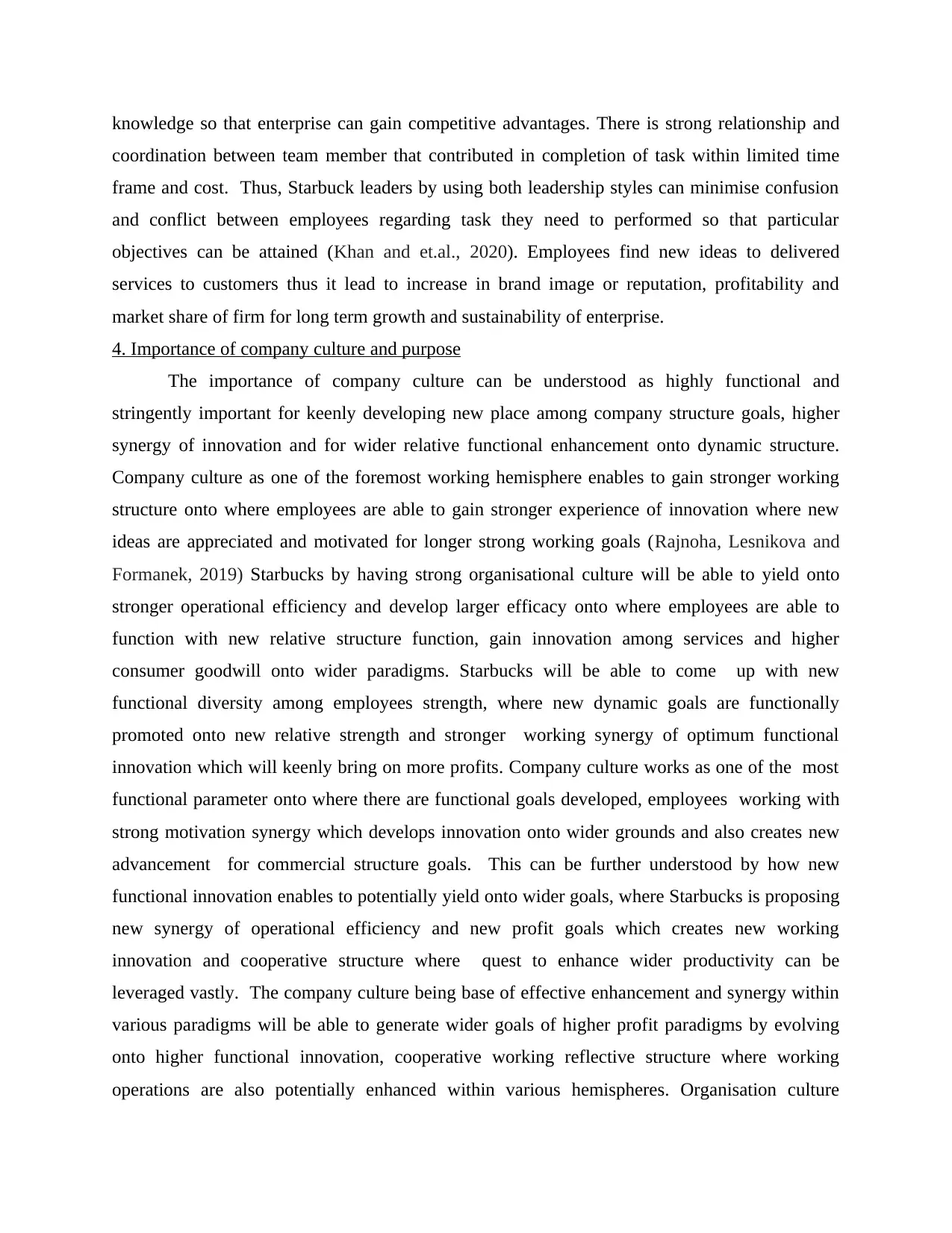
knowledge so that enterprise can gain competitive advantages. There is strong relationship and
coordination between team member that contributed in completion of task within limited time
frame and cost. Thus, Starbuck leaders by using both leadership styles can minimise confusion
and conflict between employees regarding task they need to performed so that particular
objectives can be attained (Khan and et.al., 2020). Employees find new ideas to delivered
services to customers thus it lead to increase in brand image or reputation, profitability and
market share of firm for long term growth and sustainability of enterprise.
4. Importance of company culture and purpose
The importance of company culture can be understood as highly functional and
stringently important for keenly developing new place among company structure goals, higher
synergy of innovation and for wider relative functional enhancement onto dynamic structure.
Company culture as one of the foremost working hemisphere enables to gain stronger working
structure onto where employees are able to gain stronger experience of innovation where new
ideas are appreciated and motivated for longer strong working goals (Rajnoha, Lesnikova and
Formanek, 2019) Starbucks by having strong organisational culture will be able to yield onto
stronger operational efficiency and develop larger efficacy onto where employees are able to
function with new relative structure function, gain innovation among services and higher
consumer goodwill onto wider paradigms. Starbucks will be able to come up with new
functional diversity among employees strength, where new dynamic goals are functionally
promoted onto new relative strength and stronger working synergy of optimum functional
innovation which will keenly bring on more profits. Company culture works as one of the most
functional parameter onto where there are functional goals developed, employees working with
strong motivation synergy which develops innovation onto wider grounds and also creates new
advancement for commercial structure goals. This can be further understood by how new
functional innovation enables to potentially yield onto wider goals, where Starbucks is proposing
new synergy of operational efficiency and new profit goals which creates new working
innovation and cooperative structure where quest to enhance wider productivity can be
leveraged vastly. The company culture being base of effective enhancement and synergy within
various paradigms will be able to generate wider goals of higher profit paradigms by evolving
onto higher functional innovation, cooperative working reflective structure where working
operations are also potentially enhanced within various hemispheres. Organisation culture
coordination between team member that contributed in completion of task within limited time
frame and cost. Thus, Starbuck leaders by using both leadership styles can minimise confusion
and conflict between employees regarding task they need to performed so that particular
objectives can be attained (Khan and et.al., 2020). Employees find new ideas to delivered
services to customers thus it lead to increase in brand image or reputation, profitability and
market share of firm for long term growth and sustainability of enterprise.
4. Importance of company culture and purpose
The importance of company culture can be understood as highly functional and
stringently important for keenly developing new place among company structure goals, higher
synergy of innovation and for wider relative functional enhancement onto dynamic structure.
Company culture as one of the foremost working hemisphere enables to gain stronger working
structure onto where employees are able to gain stronger experience of innovation where new
ideas are appreciated and motivated for longer strong working goals (Rajnoha, Lesnikova and
Formanek, 2019) Starbucks by having strong organisational culture will be able to yield onto
stronger operational efficiency and develop larger efficacy onto where employees are able to
function with new relative structure function, gain innovation among services and higher
consumer goodwill onto wider paradigms. Starbucks will be able to come up with new
functional diversity among employees strength, where new dynamic goals are functionally
promoted onto new relative strength and stronger working synergy of optimum functional
innovation which will keenly bring on more profits. Company culture works as one of the most
functional parameter onto where there are functional goals developed, employees working with
strong motivation synergy which develops innovation onto wider grounds and also creates new
advancement for commercial structure goals. This can be further understood by how new
functional innovation enables to potentially yield onto wider goals, where Starbucks is proposing
new synergy of operational efficiency and new profit goals which creates new working
innovation and cooperative structure where quest to enhance wider productivity can be
leveraged vastly. The company culture being base of effective enhancement and synergy within
various paradigms will be able to generate wider goals of higher profit paradigms by evolving
onto higher functional innovation, cooperative working reflective structure where working
operations are also potentially enhanced within various hemispheres. Organisation culture

functionally develops wider profitability metrics onto where there are new governance
developed, through which Starbucks will be able to gain enhanced determinants along with
strong potential synergy of best diversity goals (Vakkuri, Kemell and Abrahamsson, 2019).
Therefore, handy culture model can be used to illustrate the way it have benefited organisation in
retaining its market share and brand image. Such as:
Power culture: There are organisations that have delegated power to certain or few employees
to take all crucial decision for smooth operation of enterprise. So, there are few rules and
regulation that are define or made by few individual that needed to be abide by subordinate while
accomplishing their task (Deshwal and Ashraf Ali, 2020). Senior manager of Starbuck are
responsible for making standard rules and regulation which need to be followed by each
employees. Thus it contributes in quick decision making, rendering qualitative services to
customers and increase in profitability.
Role culture: It is type of organisational culture in which individual are delegated authority to
take decision on basis of roles and responsibilities performed by specific employees. Starbuck
has a clear organisation structure that specific task needed to be performed by particular
individuals. Therefore, on the basis of roles of employees leaders and manager delegate power to
take decision so that products or services of company can be delivered in limited time frame.
Task culture: Starbuck leaders have formed various teams according to specific task that need
to be performed by group of people that have similar or diverse knowledge and capabilities so
that best outcome can be gained (Lule, 2018). There is no single power of sources and leader
have main power to take right decision as it have more knowledge and expertise as compared to
other team members.
Person culture: This type of culture is usually avoided in starbuck as individual perceive
themselves higher or superior than organisation. Manager continuously monitors and analysis
performance of each individual so that corrective action can be taken within limited time frame.
Each individual has to abide by certain rules and regulation which limit their power to think
themselves greater than organisation.
Therefore it can be stated that organisational culture of starbuck represent core values,
ethics that are followed by enterprise to manage and operate its business in highly competitive
market condition. Strong culture of company has contributed in retention of highly skilled,
experienced and talented employees within organisation for longer period of time (Elsmore,
developed, through which Starbucks will be able to gain enhanced determinants along with
strong potential synergy of best diversity goals (Vakkuri, Kemell and Abrahamsson, 2019).
Therefore, handy culture model can be used to illustrate the way it have benefited organisation in
retaining its market share and brand image. Such as:
Power culture: There are organisations that have delegated power to certain or few employees
to take all crucial decision for smooth operation of enterprise. So, there are few rules and
regulation that are define or made by few individual that needed to be abide by subordinate while
accomplishing their task (Deshwal and Ashraf Ali, 2020). Senior manager of Starbuck are
responsible for making standard rules and regulation which need to be followed by each
employees. Thus it contributes in quick decision making, rendering qualitative services to
customers and increase in profitability.
Role culture: It is type of organisational culture in which individual are delegated authority to
take decision on basis of roles and responsibilities performed by specific employees. Starbuck
has a clear organisation structure that specific task needed to be performed by particular
individuals. Therefore, on the basis of roles of employees leaders and manager delegate power to
take decision so that products or services of company can be delivered in limited time frame.
Task culture: Starbuck leaders have formed various teams according to specific task that need
to be performed by group of people that have similar or diverse knowledge and capabilities so
that best outcome can be gained (Lule, 2018). There is no single power of sources and leader
have main power to take right decision as it have more knowledge and expertise as compared to
other team members.
Person culture: This type of culture is usually avoided in starbuck as individual perceive
themselves higher or superior than organisation. Manager continuously monitors and analysis
performance of each individual so that corrective action can be taken within limited time frame.
Each individual has to abide by certain rules and regulation which limit their power to think
themselves greater than organisation.
Therefore it can be stated that organisational culture of starbuck represent core values,
ethics that are followed by enterprise to manage and operate its business in highly competitive
market condition. Strong culture of company has contributed in retention of highly skilled,
experienced and talented employees within organisation for longer period of time (Elsmore,

2017). Thus, more and more employees or individual are motivated to be part of starbuck as it
provide supportive, friendly environment to employees regarding specific task needed to be
performed.
5 Reflection report
It can be stated that from above report I have gained lot of experienced and knowledge
that is useful in my both professional and personal life to grow and succeed. I am very happy,
satisfied after making this report as lot of research about the way external environment, CSR
activities and leadership styles helped me to know about diverse skills that are required by
individual to manage business. The first point that is pestle analysis model helps me to
understand various external factors that impact on growth and strategy of firm. I get to know
about why it is important for manage to evaluates external environment such as changes in
customers preference, policies of government and technological upgradation. I have also learned
from above report about SWOT model that helps in identifying key areas in which company
strength, weakness lies and the way they can be used to make optimum utilisation of available
opportunities and protect company from threat (Dorval, Jobin and Benomar, 2019). All such
study, research and implementation of model was much useful for me in present as well as future
circumstances in order to get best, reputable job. I have also learn lot many other thing from the
above report that is about corporate social responsibilities that need to be abided by organisation
in order to grow and sustain in market for longer period of time. I get to know that company by
incorporating social responsibilities is able to build strong brand image and gained maximum
customers satisfaction. It is much recent trend as firm operate in society so it is responsibility to
take for benefits of community or society rather than causing harm in terms of making more
wastage of resources or pollution in environment. As per my opinion, the report has also helped
me to know about different types of leadership styles that are used by leaders to inspired and
motivate diverse individual to work together as a team for achievements of goals. It also helped
me to know about types of organisational culture and its importance in growth and success of
firm. Overall it can be stated that above analysis helped me to learn more skills, knowledge
related to various aspects that are useful as future manager or leaders in any high reputable
company (Nokelainen, 2016). Therefore I felt great thankful towards my lecturer that have
assign me to prepare report on various factors that impact starbuck, different leadership styles,
CSR activities and organisation culture that lead to growth and success of organisation.
provide supportive, friendly environment to employees regarding specific task needed to be
performed.
5 Reflection report
It can be stated that from above report I have gained lot of experienced and knowledge
that is useful in my both professional and personal life to grow and succeed. I am very happy,
satisfied after making this report as lot of research about the way external environment, CSR
activities and leadership styles helped me to know about diverse skills that are required by
individual to manage business. The first point that is pestle analysis model helps me to
understand various external factors that impact on growth and strategy of firm. I get to know
about why it is important for manage to evaluates external environment such as changes in
customers preference, policies of government and technological upgradation. I have also learned
from above report about SWOT model that helps in identifying key areas in which company
strength, weakness lies and the way they can be used to make optimum utilisation of available
opportunities and protect company from threat (Dorval, Jobin and Benomar, 2019). All such
study, research and implementation of model was much useful for me in present as well as future
circumstances in order to get best, reputable job. I have also learn lot many other thing from the
above report that is about corporate social responsibilities that need to be abided by organisation
in order to grow and sustain in market for longer period of time. I get to know that company by
incorporating social responsibilities is able to build strong brand image and gained maximum
customers satisfaction. It is much recent trend as firm operate in society so it is responsibility to
take for benefits of community or society rather than causing harm in terms of making more
wastage of resources or pollution in environment. As per my opinion, the report has also helped
me to know about different types of leadership styles that are used by leaders to inspired and
motivate diverse individual to work together as a team for achievements of goals. It also helped
me to know about types of organisational culture and its importance in growth and success of
firm. Overall it can be stated that above analysis helped me to learn more skills, knowledge
related to various aspects that are useful as future manager or leaders in any high reputable
company (Nokelainen, 2016). Therefore I felt great thankful towards my lecturer that have
assign me to prepare report on various factors that impact starbuck, different leadership styles,
CSR activities and organisation culture that lead to growth and success of organisation.
Secure Best Marks with AI Grader
Need help grading? Try our AI Grader for instant feedback on your assignments.

CONCLUSION
From the above analysis it can be concluded that Covid-19 is pandemic situation that
have affected global economy and huge organisation operation. There are many organisation that
are stilling planning to cope up with uncertain situation that have lead to decreased in sales
volume and profitability of organisation. It can be illustrated from above report that Leaders of
strabuck by using participative leadership styles can motivate individual to accept recent changes
so that firm can survive in highly competitive market. At last it can be concluded that good
organisation culture can also help starbuck to raise its profit, employees and customer’s
satisfaction level.
From the above analysis it can be concluded that Covid-19 is pandemic situation that
have affected global economy and huge organisation operation. There are many organisation that
are stilling planning to cope up with uncertain situation that have lead to decreased in sales
volume and profitability of organisation. It can be illustrated from above report that Leaders of
strabuck by using participative leadership styles can motivate individual to accept recent changes
so that firm can survive in highly competitive market. At last it can be concluded that good
organisation culture can also help starbuck to raise its profit, employees and customer’s
satisfaction level.
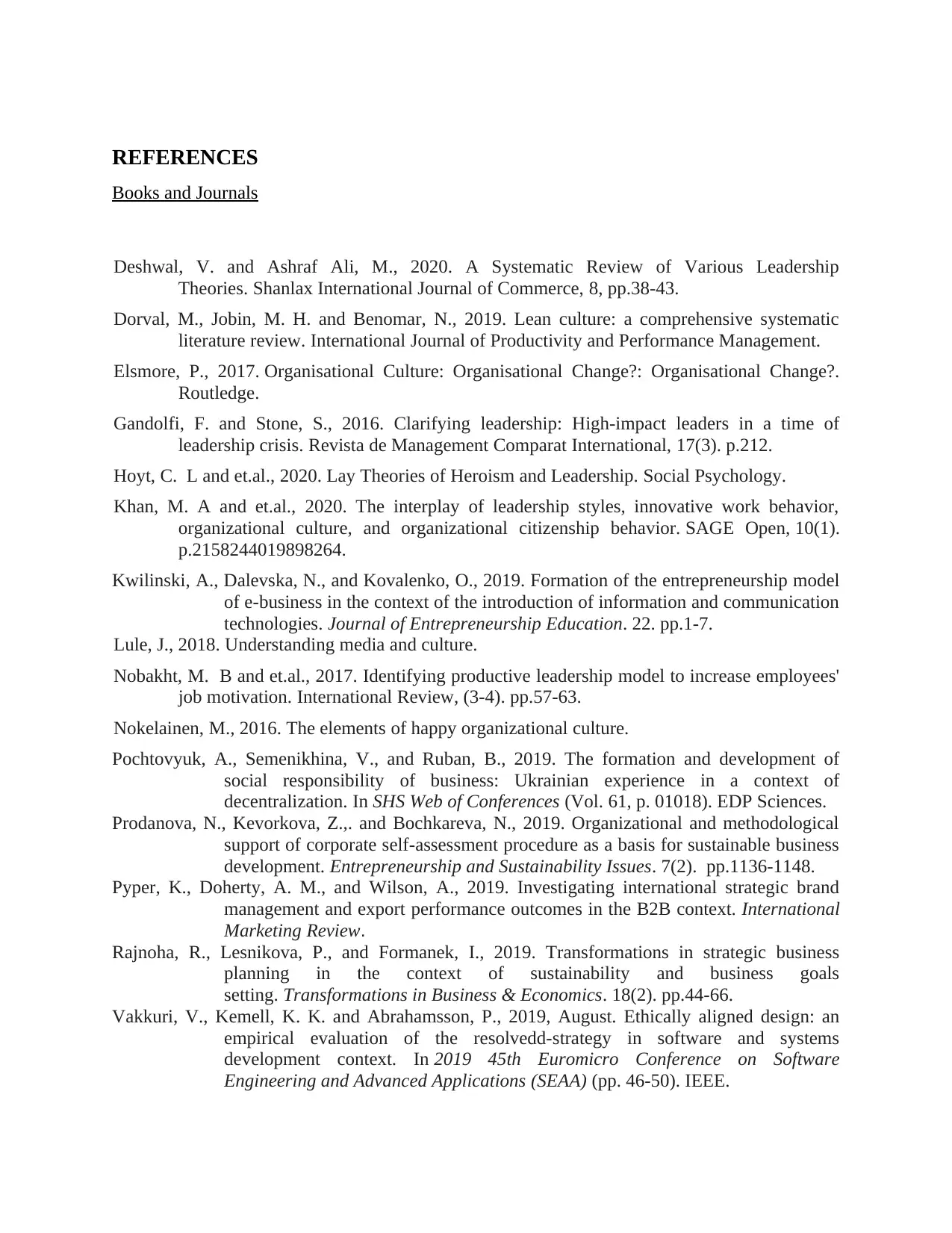
REFERENCES
Books and Journals
Deshwal, V. and Ashraf Ali, M., 2020. A Systematic Review of Various Leadership
Theories. Shanlax International Journal of Commerce, 8, pp.38-43.
Dorval, M., Jobin, M. H. and Benomar, N., 2019. Lean culture: a comprehensive systematic
literature review. International Journal of Productivity and Performance Management.
Elsmore, P., 2017. Organisational Culture: Organisational Change?: Organisational Change?.
Routledge.
Gandolfi, F. and Stone, S., 2016. Clarifying leadership: High-impact leaders in a time of
leadership crisis. Revista de Management Comparat International, 17(3). p.212.
Hoyt, C. L and et.al., 2020. Lay Theories of Heroism and Leadership. Social Psychology.
Khan, M. A and et.al., 2020. The interplay of leadership styles, innovative work behavior,
organizational culture, and organizational citizenship behavior. SAGE Open, 10(1).
p.2158244019898264.
Kwilinski, A., Dalevska, N., and Kovalenko, O., 2019. Formation of the entrepreneurship model
of e-business in the context of the introduction of information and communication
technologies. Journal of Entrepreneurship Education. 22. pp.1-7.
Lule, J., 2018. Understanding media and culture.
Nobakht, M. B and et.al., 2017. Identifying productive leadership model to increase employees'
job motivation. International Review, (3-4). pp.57-63.
Nokelainen, M., 2016. The elements of happy organizational culture.
Pochtovyuk, A., Semenikhina, V., and Ruban, B., 2019. The formation and development of
social responsibility of business: Ukrainian experience in a context of
decentralization. In SHS Web of Conferences (Vol. 61, p. 01018). EDP Sciences.
Prodanova, N., Kevorkova, Z.,. and Bochkareva, N., 2019. Organizational and methodological
support of corporate self-assessment procedure as a basis for sustainable business
development. Entrepreneurship and Sustainability Issues. 7(2). pp.1136-1148.
Pyper, K., Doherty, A. M., and Wilson, A., 2019. Investigating international strategic brand
management and export performance outcomes in the B2B context. International
Marketing Review.
Rajnoha, R., Lesnikova, P., and Formanek, I., 2019. Transformations in strategic business
planning in the context of sustainability and business goals
setting. Transformations in Business & Economics. 18(2). pp.44-66.
Vakkuri, V., Kemell, K. K. and Abrahamsson, P., 2019, August. Ethically aligned design: an
empirical evaluation of the resolvedd-strategy in software and systems
development context. In 2019 45th Euromicro Conference on Software
Engineering and Advanced Applications (SEAA) (pp. 46-50). IEEE.
Books and Journals
Deshwal, V. and Ashraf Ali, M., 2020. A Systematic Review of Various Leadership
Theories. Shanlax International Journal of Commerce, 8, pp.38-43.
Dorval, M., Jobin, M. H. and Benomar, N., 2019. Lean culture: a comprehensive systematic
literature review. International Journal of Productivity and Performance Management.
Elsmore, P., 2017. Organisational Culture: Organisational Change?: Organisational Change?.
Routledge.
Gandolfi, F. and Stone, S., 2016. Clarifying leadership: High-impact leaders in a time of
leadership crisis. Revista de Management Comparat International, 17(3). p.212.
Hoyt, C. L and et.al., 2020. Lay Theories of Heroism and Leadership. Social Psychology.
Khan, M. A and et.al., 2020. The interplay of leadership styles, innovative work behavior,
organizational culture, and organizational citizenship behavior. SAGE Open, 10(1).
p.2158244019898264.
Kwilinski, A., Dalevska, N., and Kovalenko, O., 2019. Formation of the entrepreneurship model
of e-business in the context of the introduction of information and communication
technologies. Journal of Entrepreneurship Education. 22. pp.1-7.
Lule, J., 2018. Understanding media and culture.
Nobakht, M. B and et.al., 2017. Identifying productive leadership model to increase employees'
job motivation. International Review, (3-4). pp.57-63.
Nokelainen, M., 2016. The elements of happy organizational culture.
Pochtovyuk, A., Semenikhina, V., and Ruban, B., 2019. The formation and development of
social responsibility of business: Ukrainian experience in a context of
decentralization. In SHS Web of Conferences (Vol. 61, p. 01018). EDP Sciences.
Prodanova, N., Kevorkova, Z.,. and Bochkareva, N., 2019. Organizational and methodological
support of corporate self-assessment procedure as a basis for sustainable business
development. Entrepreneurship and Sustainability Issues. 7(2). pp.1136-1148.
Pyper, K., Doherty, A. M., and Wilson, A., 2019. Investigating international strategic brand
management and export performance outcomes in the B2B context. International
Marketing Review.
Rajnoha, R., Lesnikova, P., and Formanek, I., 2019. Transformations in strategic business
planning in the context of sustainability and business goals
setting. Transformations in Business & Economics. 18(2). pp.44-66.
Vakkuri, V., Kemell, K. K. and Abrahamsson, P., 2019, August. Ethically aligned design: an
empirical evaluation of the resolvedd-strategy in software and systems
development context. In 2019 45th Euromicro Conference on Software
Engineering and Advanced Applications (SEAA) (pp. 46-50). IEEE.
1 out of 12
Related Documents
Your All-in-One AI-Powered Toolkit for Academic Success.
+13062052269
info@desklib.com
Available 24*7 on WhatsApp / Email
![[object Object]](/_next/static/media/star-bottom.7253800d.svg)
Unlock your academic potential
© 2024 | Zucol Services PVT LTD | All rights reserved.




